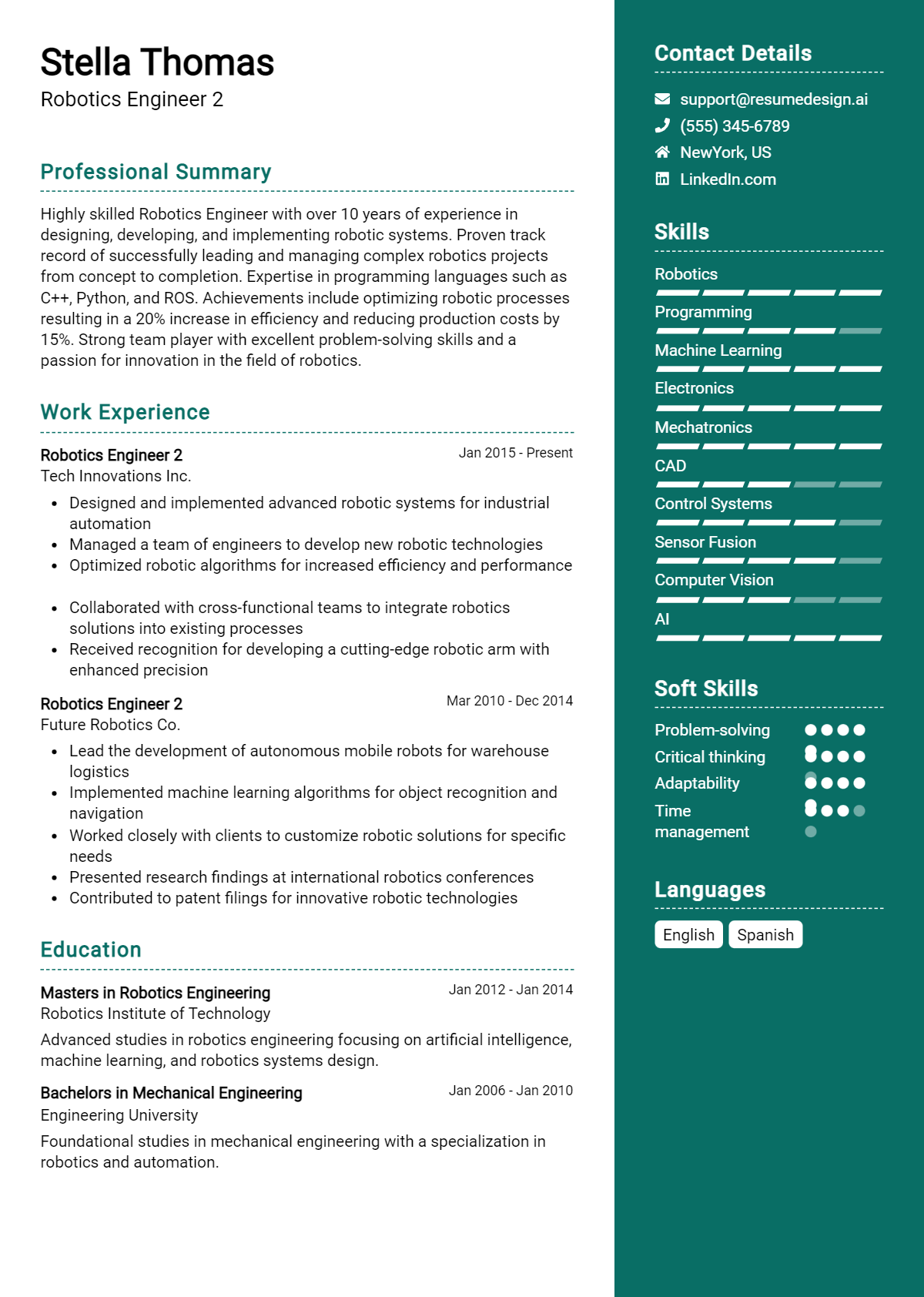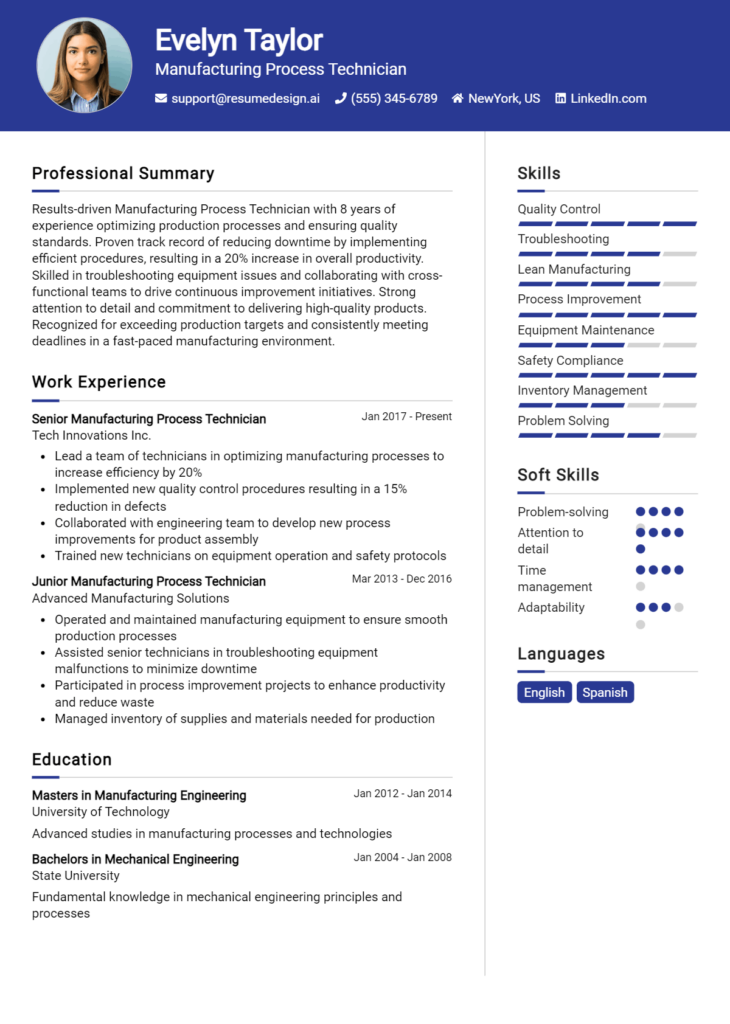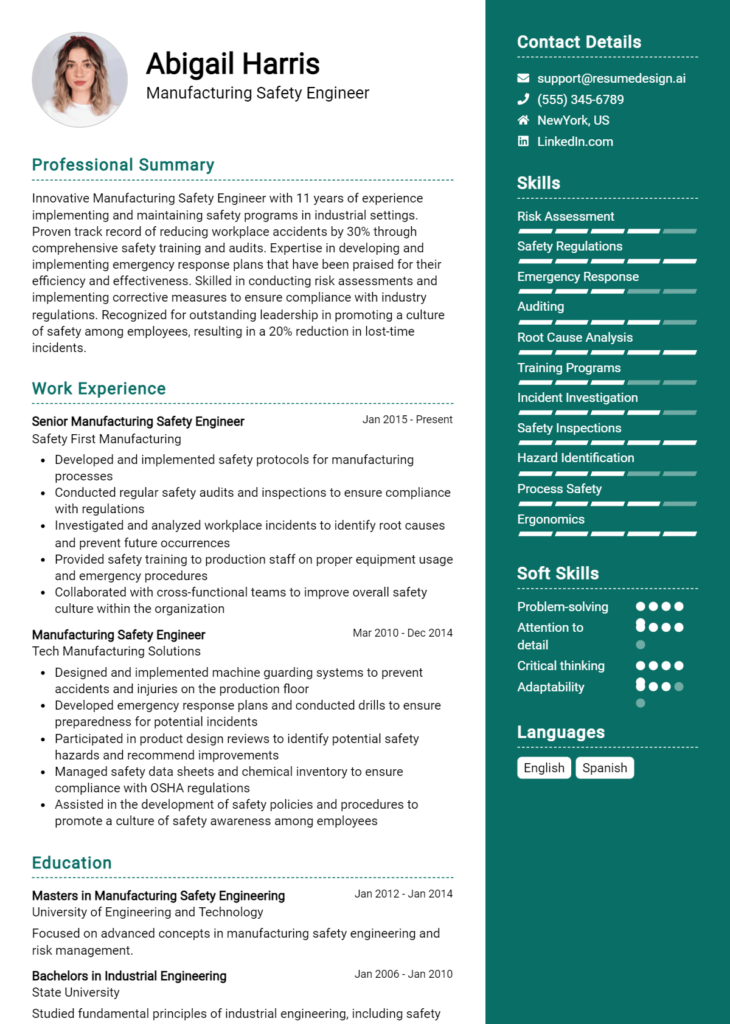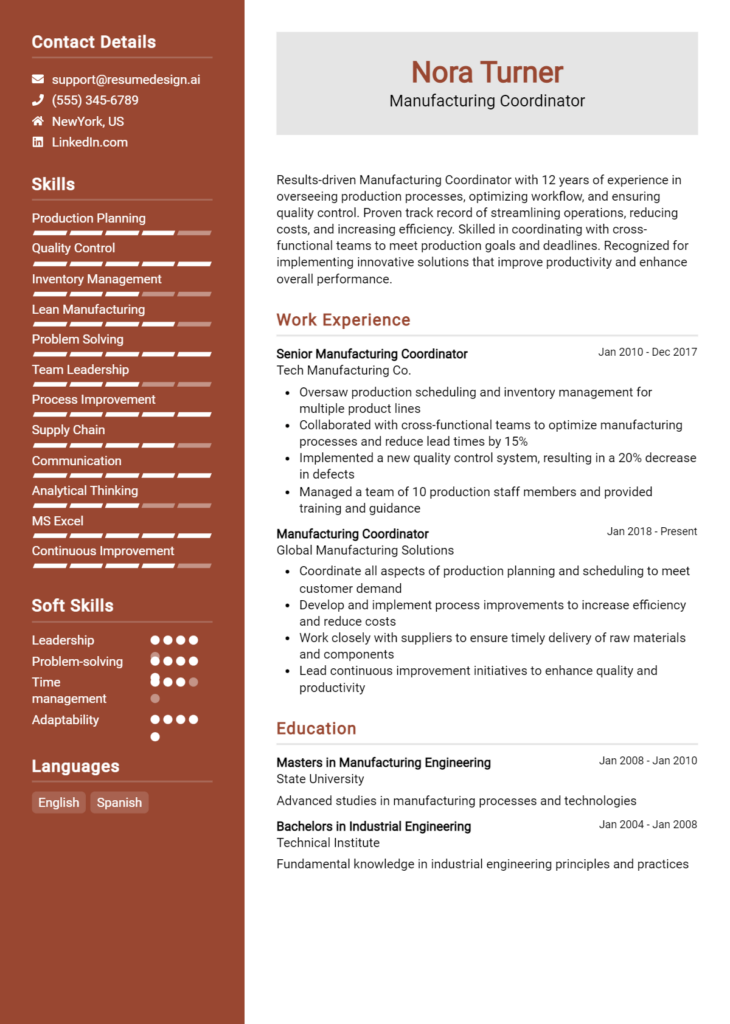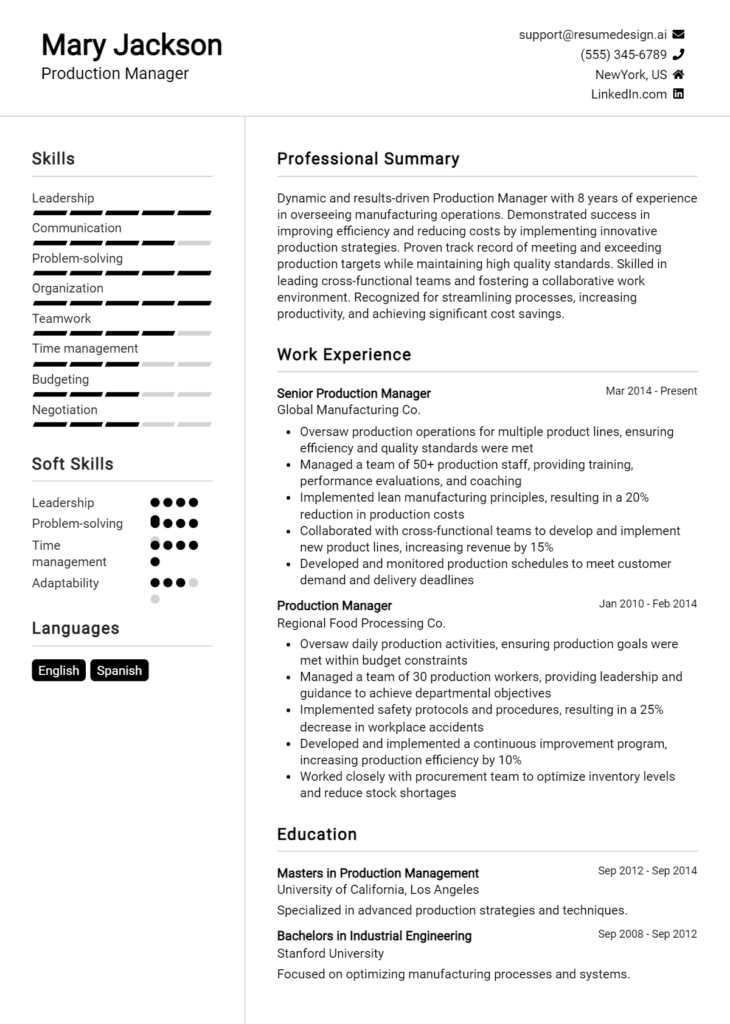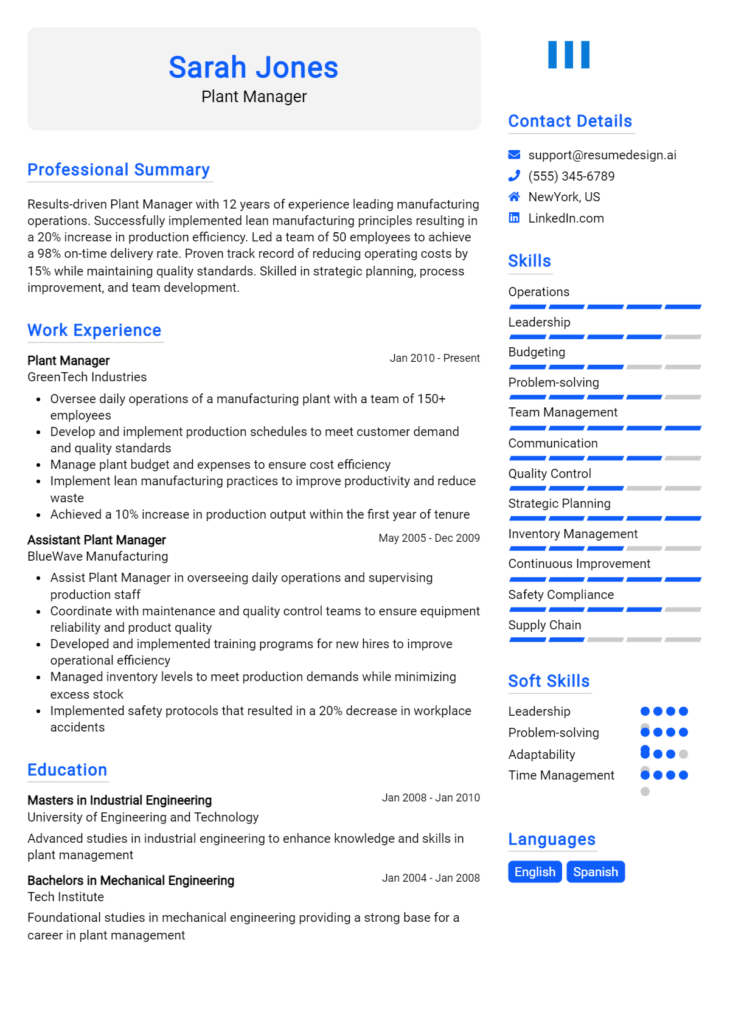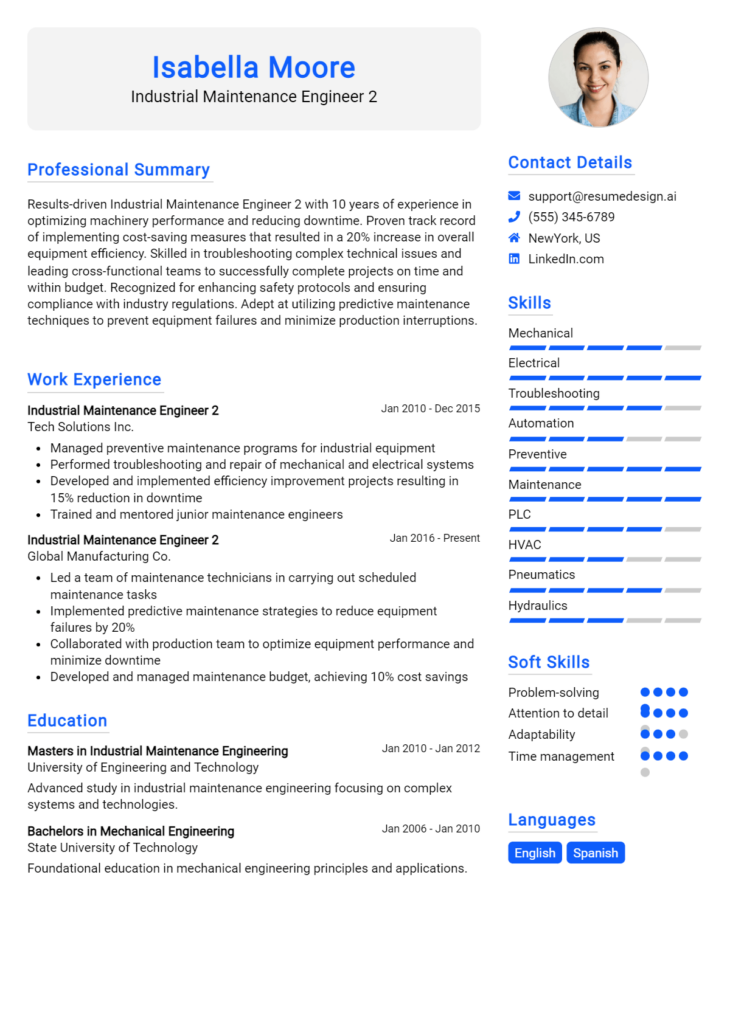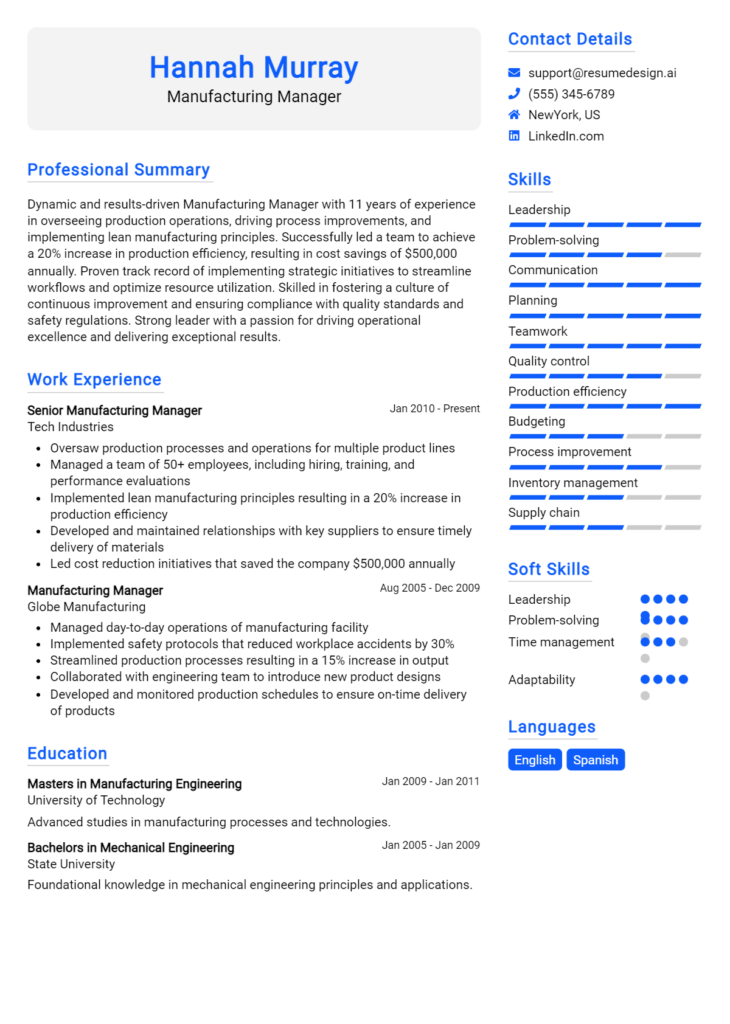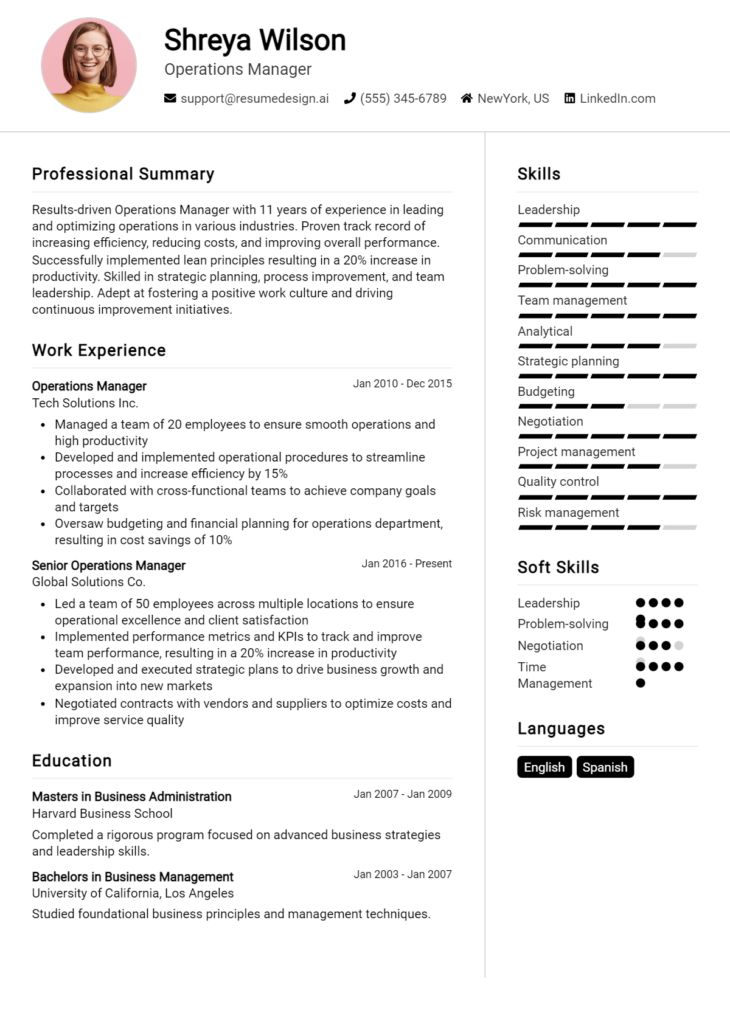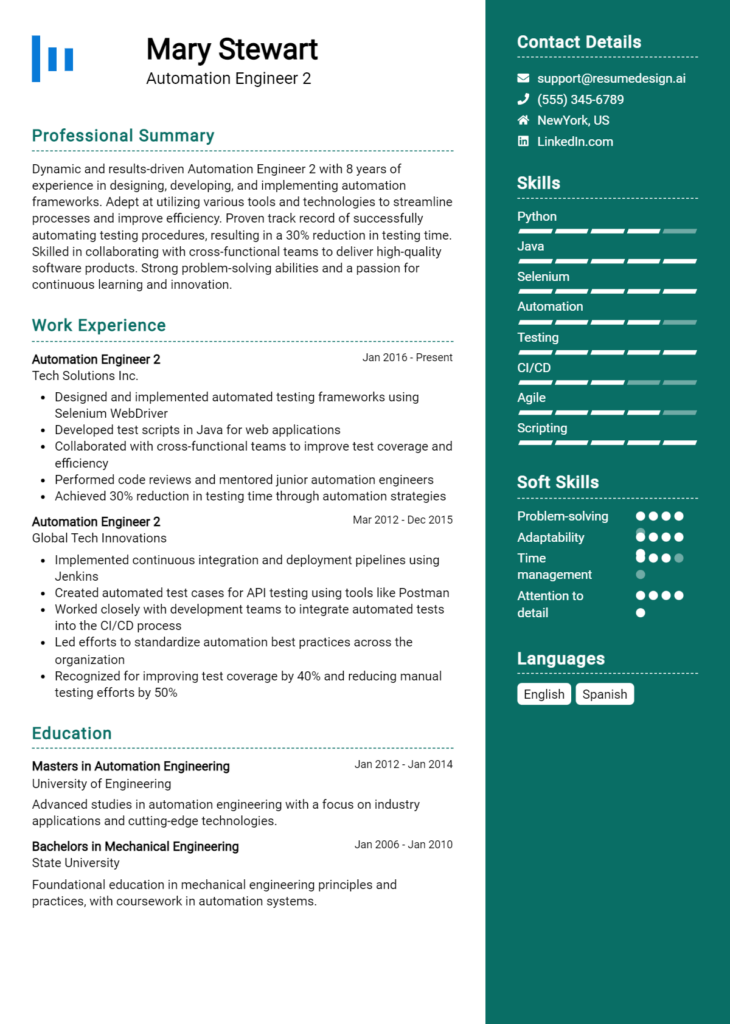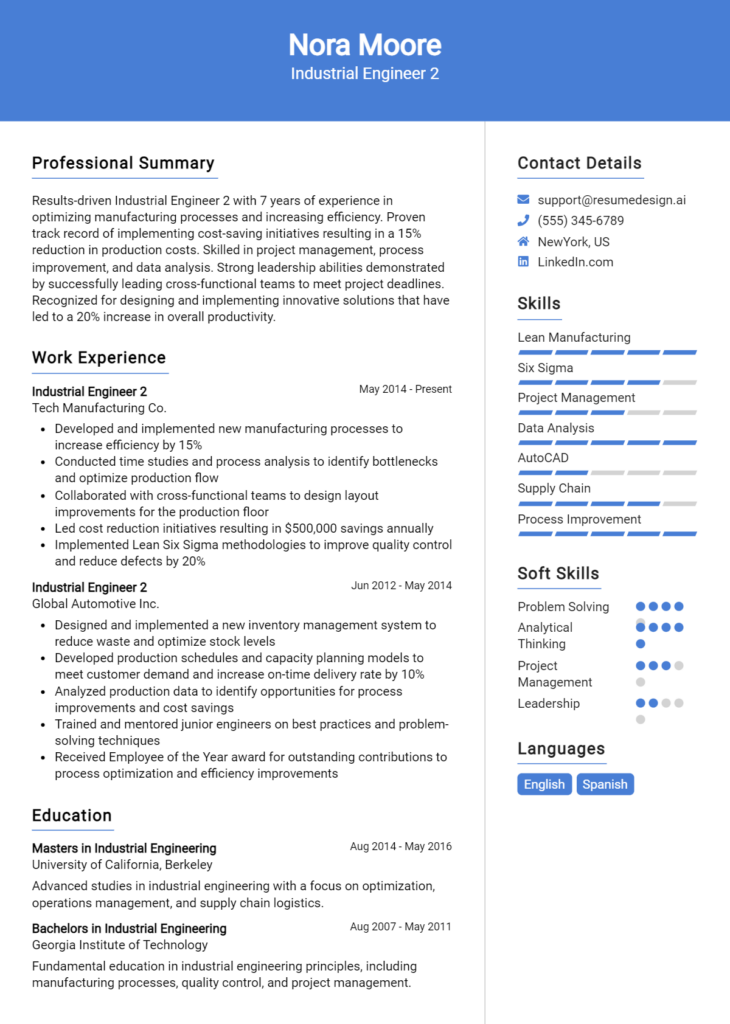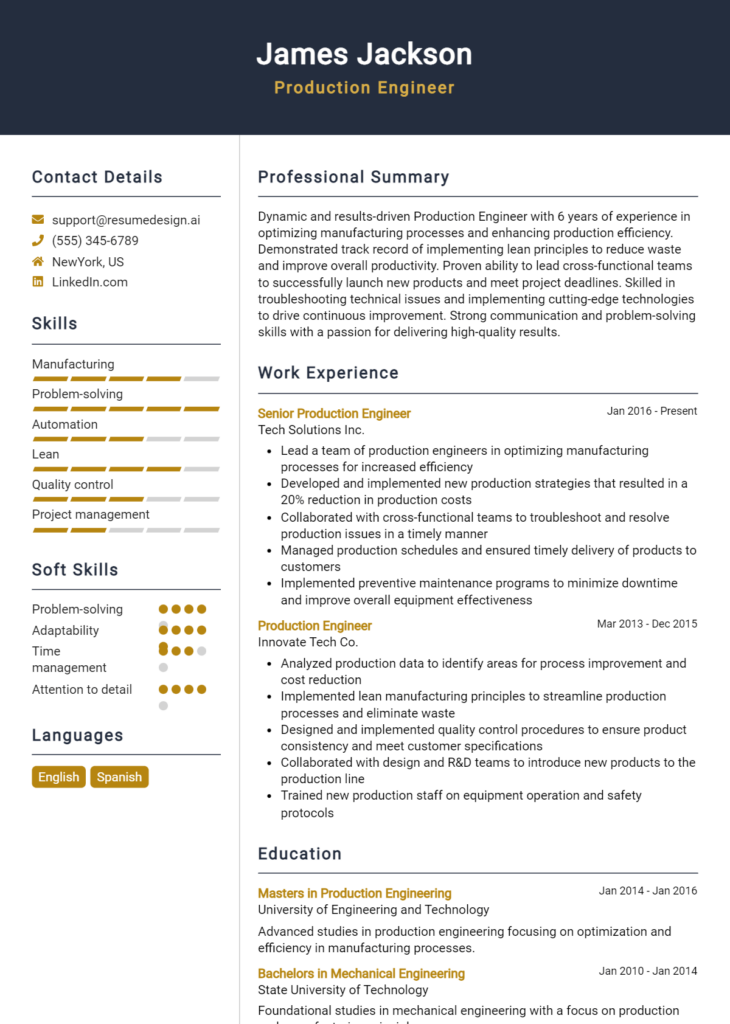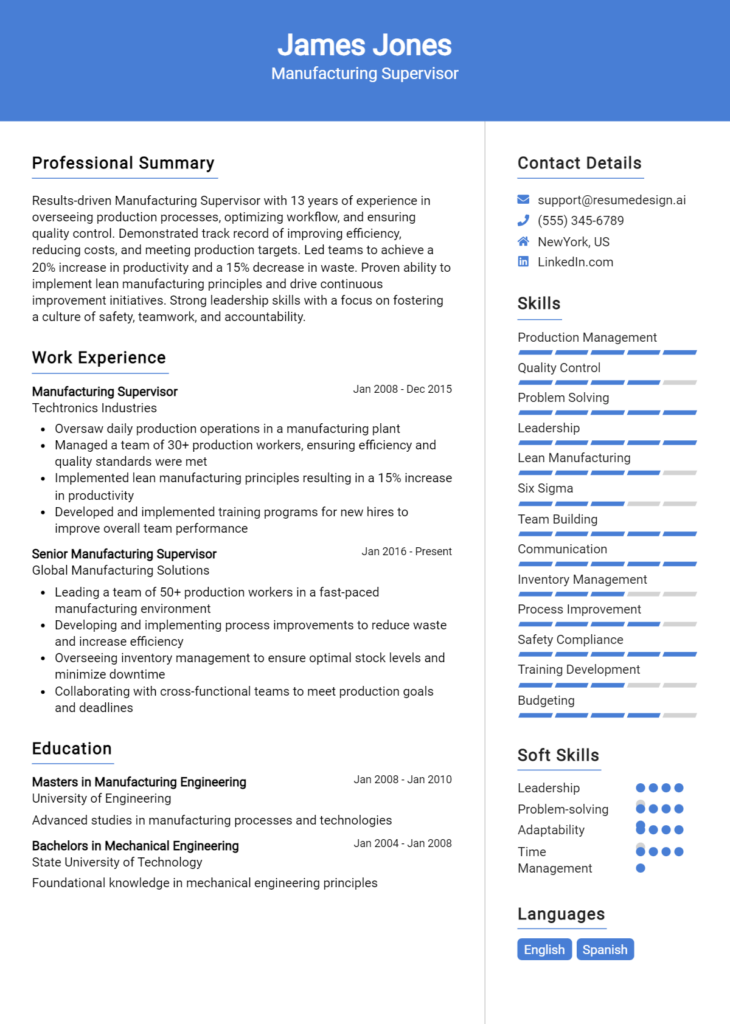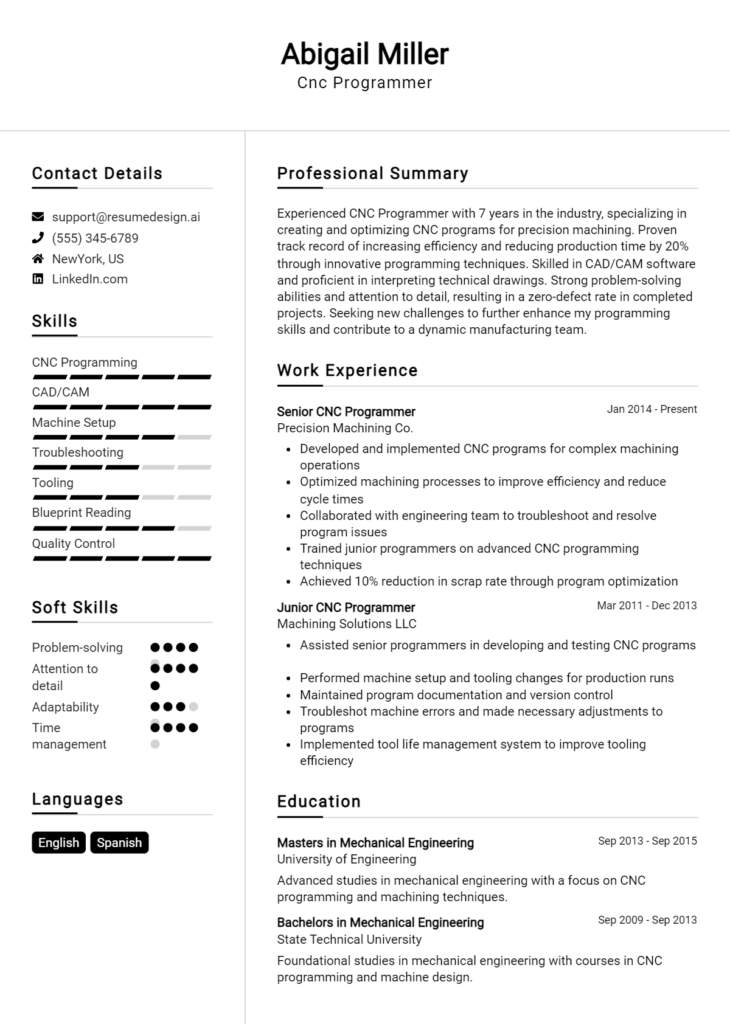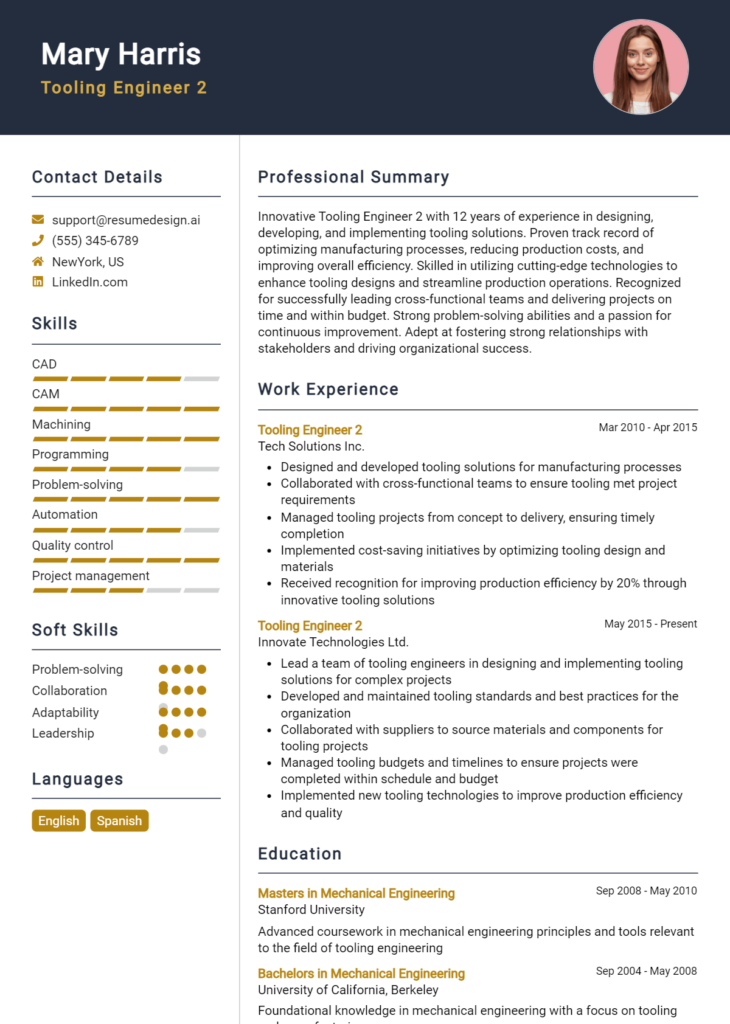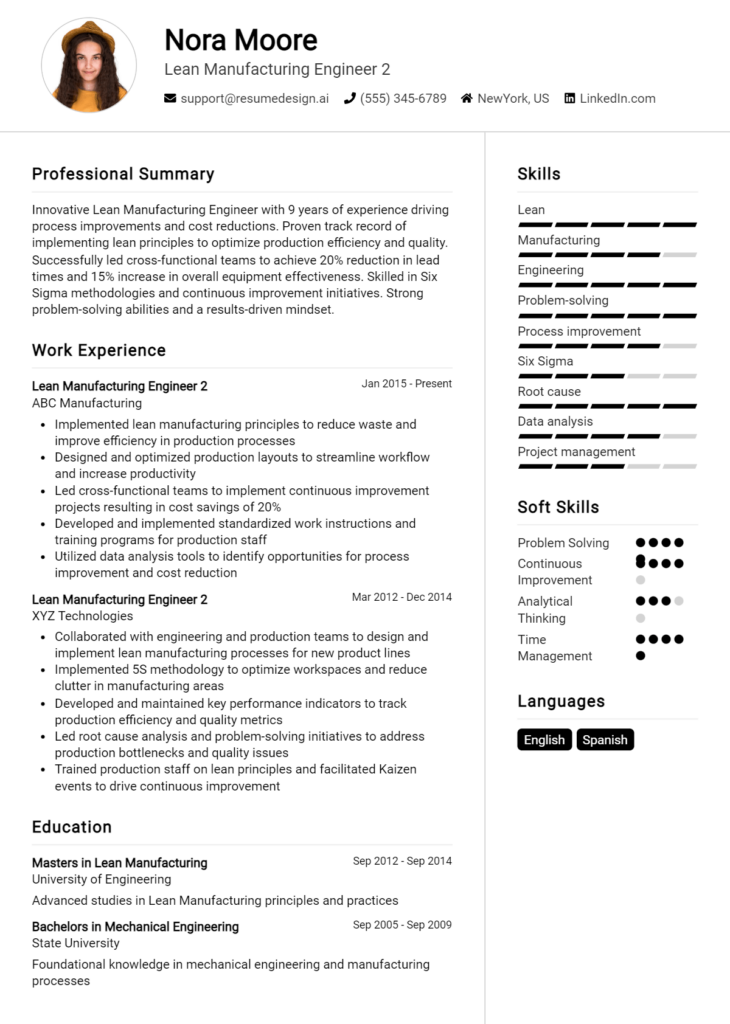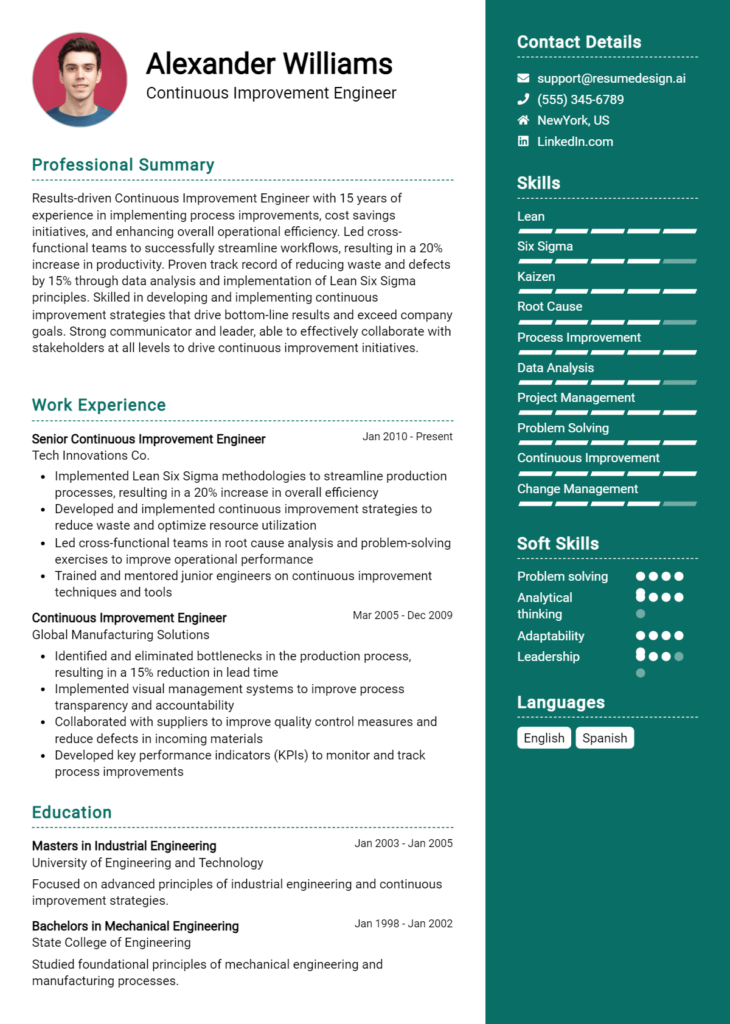Robotics Engineer Core Responsibilities
A Robotics Engineer plays a pivotal role in integrating mechanical, electrical, and software engineering to design and develop robotic systems. Key responsibilities include creating prototypes, programming robotic systems, and troubleshooting operational issues. Strong technical expertise, operational understanding, and exceptional problem-solving skills are essential for success. These abilities help bridge various departments, ensuring that robotics projects align with organizational goals. A well-structured resume can effectively highlight these qualifications, showcasing the candidate's capacity to contribute to innovation and efficiency.
Common Responsibilities Listed on Robotics Engineer Resume
- Design and develop robotic systems and components.
- Program and test robotic applications and software.
- Conduct feasibility studies and prototype testing.
- Collaborate with cross-functional teams to integrate robotics solutions.
- Troubleshoot and resolve technical issues in robotic systems.
- Document engineering processes and project specifications.
- Ensure compliance with safety standards and regulations.
- Perform regular maintenance and upgrades of robotic systems.
- Analyze performance metrics and optimize robotic operations.
- Stay updated with industry trends and technological advancements.
- Provide training and support for end-users of robotic systems.
High-Level Resume Tips for Robotics Engineer Professionals
In the competitive field of robotics engineering, a well-crafted resume serves as a vital tool for professionals aiming to make a strong first impression on potential employers. Your resume is often the first point of contact between you and a hiring manager, and it must effectively reflect not just your technical skills but also your notable achievements in the field. A standout resume can differentiate you from other candidates, showcasing your unique qualifications and experiences that are directly relevant to the role. This guide will provide practical and actionable resume tips specifically tailored for Robotics Engineer professionals, helping you to present your best self to prospective employers.
Top Resume Tips for Robotics Engineer Professionals
- Tailor your resume to match the job description, emphasizing relevant skills and experiences that align with the specific role.
- Highlight your technical skills prominently, such as programming languages, software tools, and robotics platforms you are proficient in.
- Showcase relevant work experience, including internships, projects, and research, to demonstrate your practical application of robotics engineering principles.
- Quantify your achievements with metrics, such as the percentage of efficiency improvements, cost reductions, or successful project completions.
- Include keywords from the job posting to ensure your resume passes through Applicant Tracking Systems (ATS) and reaches hiring managers.
- Feature any certifications or specialized training that enhance your qualifications, such as robotics certifications or software training.
- Incorporate a summary statement at the top that succinctly captures your professional background, skills, and career objectives.
- Provide links to your online portfolio, GitHub, or relevant projects that showcase your work and contributions to the field.
- Keep the layout clean and professional, using clear headings and bullet points to enhance readability and emphasize key information.
By implementing these tips into your resume, you can significantly increase your chances of landing a job in the Robotics Engineer field. A targeted and well-structured resume not only highlights your qualifications but also demonstrates your commitment to professionalism, making you an attractive candidate to potential employers.
Why Resume Headlines & Titles are Important for Robotics Engineer
In the competitive field of robotics engineering, a well-crafted resume headline or title plays a crucial role in making a strong first impression on hiring managers. A powerful headline can effectively summarize a candidate's key qualifications and unique skills in just a few words, acting as a hook that draws attention amidst a sea of applications. It should be concise, relevant, and directly aligned with the specific job being pursued, allowing recruiters to quickly grasp the candidate's expertise and potential fit for the role.
Best Practices for Crafting Resume Headlines for Robotics Engineer
- Keep it concise: Aim for one impactful phrase that captures your essence.
- Be role-specific: Tailor your headline to match the job description and requirements.
- Highlight key skills: Include your most relevant skills that set you apart in the robotics field.
- Use industry terminology: Incorporate keywords that are familiar in the robotics engineering domain.
- Showcase achievements: If possible, reference quantifiable results or notable projects.
- Avoid generic terms: Steer clear of vague phrases that do not convey your unique qualifications.
- Make it compelling: Use strong adjectives and action-oriented language to convey confidence.
- Revise for clarity: Ensure your headline is easy to understand and quickly communicates your value.
Example Resume Headlines for Robotics Engineer
Strong Resume Headlines
Innovative Robotics Engineer Specializing in Autonomous Systems and Machine Learning
Results-Driven Robotics Engineer with 5+ Years in Industrial Automation
Creative Robotics Engineer with Proven Track Record in Robotic Process Automation
Experienced Robotics Engineer Focused on AI-Driven Solutions for Manufacturing
Weak Resume Headlines
Robotics Engineer Looking for Opportunities
Engineering Professional with Robotics Experience
The strong headlines are effective because they are specific, action-oriented, and highlight the candidate's unique strengths and experiences within the robotics sector. They immediately convey what the applicant brings to the table, making them memorable to hiring managers. In contrast, the weak headlines fail to impress as they lack specificity and enthusiasm, making it difficult for recruiters to see the candidate's value or differentiate them from others in the field.
Writing an Exceptional Robotics Engineer Resume Summary
A well-crafted resume summary is essential for a Robotics Engineer, as it serves as the first impression for hiring managers. This brief introductory section quickly captures attention by highlighting key skills, relevant experience, and significant accomplishments that align with the job role. A strong summary should be concise yet impactful, effectively showcasing the candidate's qualifications while being tailored to the specific position they are applying for. This tailored approach increases the chances of standing out in a competitive job market, making it an invaluable component of a successful resume.
Best Practices for Writing a Robotics Engineer Resume Summary
- Quantify Achievements: Use numbers and metrics to demonstrate the impact of your work, such as efficiency improvements or project completion rates.
- Focus on Relevant Skills: Highlight technical skills, programming languages, and tools that are pertinent to the role and industry.
- Tailor the Summary: Customize your summary for each job application by incorporating keywords and phrases from the job description.
- Showcase Industry Experience: Include specific experiences that demonstrate your familiarity with robotics and related technologies.
- Highlight Problem-Solving Abilities: Emphasize instances where you successfully overcame challenges in your projects or work environment.
- Use Strong Action Verbs: Start sentences with dynamic verbs to convey a sense of action and accomplishment.
- Keep it Concise: Aim for 3-5 sentences that deliver maximum impact without overwhelming the reader.
- Maintain Professional Tone: Use clear, professional language that reflects your expertise in the field.
Example Robotics Engineer Resume Summaries
Strong Resume Summaries
Results-driven Robotics Engineer with over 5 years of experience in designing and implementing automated systems, leading to a 30% increase in production efficiency. Proficient in ROS, Python, and machine learning algorithms, with a proven track record of developing innovative solutions that reduce costs by 15%.
Dedicated Robotics Engineer skilled in advanced robotics systems and artificial intelligence, having successfully led a cross-functional team in developing a robotic arm that improved assembly line speed by 25%. Strong background in CAD software and project management, with a commitment to delivering high-quality results.
Innovative Robotics Engineer with expertise in programming and integrating robotic systems, contributing to the launch of three major projects that enhanced operational efficiency by 40%. Adept in sensor technologies and feedback control systems, with a passion for advancing automation in manufacturing.
Weak Resume Summaries
Robotics Engineer with experience in various projects. Skilled in some programming languages and technologies. Looking for a new opportunity to grow.
Motivated engineer interested in robotics and automation. Has worked on multiple projects but is not focused on any specific area. Seeking a job in the engineering field.
The strong resume summaries are effective because they provide specific details about the candidate's achievements and skills, including quantifiable results and relevant technologies. They demonstrate the candidate's direct impact on previous projects, making them compelling and tailored to the role. In contrast, the weak resume summaries are vague and lack concrete examples or measurable outcomes, which diminishes their effectiveness and makes it difficult for hiring managers to gauge the candidate's true qualifications and potential contributions.
Work Experience Section for Robotics Engineer Resume
The work experience section of a Robotics Engineer resume is critical as it serves as a platform to exhibit the candidate's technical proficiencies, management capabilities, and commitment to delivering high-quality products. This section not only highlights hands-on experience with robotics systems and technologies but also demonstrates the ability to lead teams effectively and execute projects that meet industry standards. By quantifying achievements—such as successful project completions, budget adherence, and performance improvements—candidates can present a compelling narrative that aligns their experience with the expectations of employers in the robotics field.
Best Practices for Robotics Engineer Work Experience
- Use clear, concise language to describe responsibilities and achievements.
- Quantify results wherever possible, using metrics such as efficiency improvements or cost reductions.
- Highlight specific technical skills and tools used in projects, such as programming languages, software, and hardware.
- Emphasize teamwork and collaboration on projects, indicating your role in achieving collective goals.
- Tailor your experience to align with the job description, utilizing relevant keywords.
- Include certifications and training that enhance your qualifications in robotics engineering.
- Showcase leadership experiences, such as managing projects or mentoring junior engineers.
- Provide context for projects, explaining the challenges faced and how they were overcome.
Example Work Experiences for Robotics Engineer
Strong Experiences
- Led a team of 5 engineers in the development of an autonomous robotic system that improved warehouse efficiency by 30%, resulting in a $500,000 cost savings annually.
- Designed and implemented a machine learning algorithm for robotic vision, increasing object detection accuracy by 25% and reducing error rates in sorting tasks.
- Managed the full project lifecycle for a robotic arm integration project, completing it 2 months ahead of schedule and achieving a 20% reduction in production time.
- Collaborated with cross-functional teams to develop a prototype for a drone delivery system, which successfully passed all regulatory testing within the first submission.
Weak Experiences
- Worked on various robotics projects.
- Assisted in programming tasks for robotic systems.
- Participated in team meetings to discuss project updates.
- Helped with the assembly of robotic components.
The strong experiences are considered effective because they provide specific, quantifiable outcomes that showcase the candidate's technical expertise and leadership abilities. Each bullet point clearly details the impact of their work, demonstrating a direct correlation between their efforts and measurable success. In contrast, the weak experiences lack detail and specificity, failing to highlight the candidate's contributions or the significance of their roles in projects. As a result, they do not effectively convey the candidate's qualifications or value to potential employers in the robotics industry.
Education and Certifications Section for Robotics Engineer Resume
The education and certifications section of a Robotics Engineer resume is crucial in showcasing the candidate's academic qualifications and commitment to professional development. This section not only highlights the foundational knowledge acquired through degrees in relevant fields such as robotics, mechanical engineering, or computer science but also emphasizes industry-relevant certifications that demonstrate specialized skills and expertise. By providing a comprehensive overview of relevant coursework, certifications, and any specialized training, candidates can significantly enhance their credibility and align themselves more closely with the demands of the job role. Continuous learning is paramount in the rapidly evolving field of robotics, making this section an essential component of an effective resume.
Best Practices for Robotics Engineer Education and Certifications
- Include only relevant degrees and certifications that pertain to robotics or related fields.
- List advanced degrees (Master's or PhD) before undergraduate degrees to emphasize higher education.
- Highlight industry-recognized certifications, such as those from IEEE or ASME, to demonstrate credibility.
- Provide details on specific coursework that directly relates to the job description, such as courses in control systems, machine learning, or artificial intelligence.
- Keep the section concise, focusing on the most pertinent qualifications without unnecessary information.
- Include any specialized training programs or workshops that enhance technical skills relevant to robotics.
- Use a clear format that makes it easy for hiring managers to quickly identify qualifications.
- Update this section regularly to reflect new educational achievements or certifications obtained.
Example Education and Certifications for Robotics Engineer
Strong Examples
- M.S. in Robotics Engineering, Stanford University, 2022
- Certified Robotics Technician (CRT), Robotics Industries Association, 2023
- Coursework: Advanced Control Systems, Machine Learning for Robotics, and Autonomous Systems Design
- B.S. in Mechanical Engineering, University of California, Berkeley, 2020
Weak Examples
- High School Diploma, Springfield High School, 2015
- Certification in Basic Electronics, Local Community College, 2016
- Bachelor of Arts in Philosophy, University of Anywhere, 2018
- Online Course in Creative Writing, Coursera, 2021
The strong examples are considered relevant as they reflect advanced education and industry-recognized certifications that align with the technical competencies required for a Robotics Engineer. These qualifications demonstrate a clear focus on robotics and engineering, showcasing the candidate's preparedness for the role. Conversely, the weak examples highlight educational qualifications and certifications that are either outdated, irrelevant to the field of robotics, or not indicative of advanced technical skills. This disparity emphasizes the importance of selecting appropriate qualifications that directly enhance a candidate's fit for the position.
Top Skills & Keywords for Robotics Engineer Resume
In the competitive field of robotics engineering, showcasing the right skills on your resume can significantly enhance your chances of landing your desired position. Employers look for a blend of both hard and soft skills that demonstrate not only your technical proficiency but also your ability to work collaboratively and adapt to changing environments. Highlighting these competencies effectively can set you apart from other candidates and illustrate your suitability for the role. For more insights on how to effectively present your skills, check out skills and ensure your work experience complements your capabilities by visiting work experience.
Top Hard & Soft Skills for Robotics Engineer
Soft Skills
- Problem-solving
- Team collaboration
- Communication
- Creativity
- Adaptability
- Time management
- Critical thinking
- Attention to detail
- Leadership
- Conflict resolution
- Analytical thinking
- Project management
- Interpersonal skills
- Emotional intelligence
Hard Skills
- Proficiency in programming languages (e.g., C++, Python, Java)
- Robotics simulation software expertise (e.g., ROS, Gazebo)
- Knowledge of control systems
- Familiarity with machine learning algorithms
- Experience with CAD software (e.g., SolidWorks, AutoCAD)
- Understanding of embedded systems
- Sensor integration
- Circuit design and analysis
- 3D modeling and prototyping
- Robotics hardware design
- Familiarity with AI and neural networks
- Knowledge of mechatronics principles
- Data analysis and visualization
- System testing and validation techniques
- Familiarity with automation tools and technologies
- Troubleshooting and debugging skills
- Understanding of safety standards and regulations in robotics
Stand Out with a Winning Robotics Engineer Cover Letter
Dear [Hiring Manager's Name],
I am writing to express my interest in the Robotics Engineer position at [Company Name] as advertised on [where you found the job listing]. With a Master’s degree in Robotics and over three years of hands-on experience in designing and programming robotic systems, I am confident in my ability to contribute effectively to your innovative team. My background in both mechanical and software engineering, coupled with my passion for automation technology, has equipped me with the skills necessary to excel in this role.
In my previous position at [Previous Company Name], I successfully led a project that involved the development of an autonomous robotic arm designed for precision tasks in a manufacturing environment. By collaborating closely with cross-functional teams, I implemented machine learning algorithms that increased the arm's efficiency by 30%. My proficiency in programming languages such as Python and C++, along with my experience with ROS (Robot Operating System), has allowed me to create adaptable and scalable robotic solutions that meet and exceed project requirements.
I am particularly impressed by [Company Name]'s commitment to pushing the boundaries of robotics in [specific area relevant to the company], and I am excited about the opportunity to contribute to such groundbreaking work. I am eager to bring my expertise in robotic design and programming, as well as my strong problem-solving abilities, to your team. I believe that my proactive approach and dedication to continuous learning will make me a valuable asset to [Company Name] as we tackle the challenges of tomorrow's technology.
Thank you for considering my application. I look forward to the possibility of discussing how my skills and experiences align with the goals of your team. Please feel free to contact me at [your phone number] or [your email] to schedule a conversation.
Sincerely,
[Your Name]
[Your LinkedIn Profile or Portfolio Website]
Common Mistakes to Avoid in a Robotics Engineer Resume
When crafting a resume for a Robotics Engineer position, it’s crucial to present your skills and experiences effectively. However, many candidates make common mistakes that can undermine their chances of landing an interview. Understanding these pitfalls can help you fine-tune your resume to better showcase your qualifications and stand out in a competitive job market.
Generic Objective Statements: Using vague or generic objective statements fails to capture the attention of hiring managers. Tailoring your objective to the specific role you're applying for demonstrates genuine interest and alignment with the job.
Overloading with Technical Jargon: While technical skills are crucial, excessive jargon can alienate recruiters who may not have a technical background. Strive for a balance by clearly explaining your skills while keeping the language accessible.
Neglecting Soft Skills: Focusing solely on technical competencies can give an incomplete picture. Highlighting soft skills like teamwork, communication, and problem-solving is essential as they are highly valued in collaborative environments.
Inconsistent Formatting: A cluttered or inconsistent resume can create confusion. Use a uniform format for headings, bullet points, and font sizes to enhance readability and professionalism.
Listing Responsibilities Instead of Achievements: Simply outlining your job responsibilities doesn’t demonstrate your impact. Instead, focus on specific achievements and quantify them where possible (e.g., "Improved efficiency by 20% through automation").
Ignoring Relevant Projects: Failing to include relevant projects or coursework can leave your resume lacking substance. Showcase any robotics projects, internships, or competitions that highlight your practical experience in the field.
Omitting Keywords from Job Descriptions: Many companies use Applicant Tracking Systems (ATS) to screen resumes. Not including relevant keywords from the job description can result in your resume being overlooked.
Not Proofreading: Typos and grammatical errors can create a negative impression. Always proofread your resume or have someone else review it to ensure it’s polished and free of mistakes.
Conclusion
As we explored the essential skills and qualifications necessary for a Robotics Engineer, we highlighted the importance of a well-crafted resume that effectively showcases your technical expertise and project experiences. Key attributes such as proficiency in programming languages (like Python and C++), knowledge of robotics frameworks (such as ROS), and hands-on experience with robotics hardware were emphasized as critical for standing out in this competitive field.
Additionally, we discussed the significance of soft skills, including teamwork, problem-solving, and communication, which are vital for collaborating with multidisciplinary teams. Keeping your resume updated with your latest projects, certifications, and relevant experiences can significantly boost your chances of landing that dream role in robotics engineering.
Now that you have a clearer understanding of what to include in your resume, it’s time to take action! Review your current Robotics Engineer resume to ensure it highlights your strengths and aligns with industry demands. To assist you, consider utilizing valuable resources such as resume templates, a convenient resume builder, and resume examples that can serve as inspiration. Don't forget to also check out our cover letter templates to complement your application. Start refining your resume today and position yourself for success in the dynamic field of robotics engineering!

